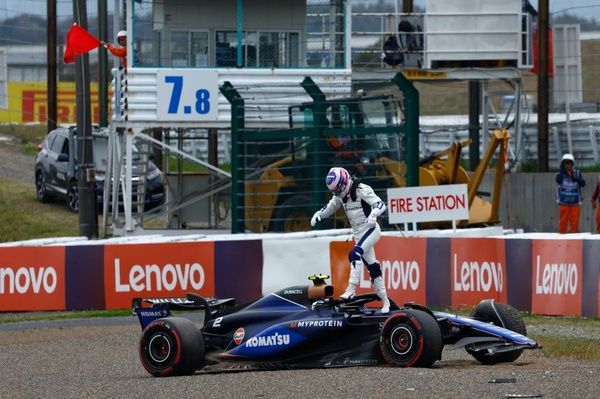Bahrain GP: F1 technical images direct from the pitlane
Join us as we delve into the Formula 1 technical features on display in the pitlane as teams prepare for the Bahrain Grand Prix, courtesy of Giorgio Piola and Sutton Images.

Photo by: Giorgio Piola

Alfa Romeo C43 technical detail
Photo by: Giorgio Piola
Alfa Romeo is the first team to apply a solution that was pioneered by Mercedes in 2022, with the Swiss-based outfit looking to refine the flow structures at the front of the car, to improve performance downstream.
Mercedes introduced its widebody chassis blister solution as part of a larger package of updates at the British Grand Prix last year. That suite of parts helped to soothe some of the ill effects posed by porpoising that it suffered in the opening half of the season but also helped the team to unlock some of the latent potential in the W13.
The widebody chassis blisters have been retained on the W14 and optimised around the changes made to the suspension for 2023. While Alfa completed its pre-season test without such an arrangement, it has been added for the race weekend.

Mercedes W13 suspension detail
Photo by: Giorgio Piola

Mercedes W14 side pod
Photo by: Giorgio Piola
The wishbones, steering arms and pull- or push-rods in use are all already mounted in ways that encourage the best possible flow patterns, with many designers orienting them in order to improve the airflow's passage to the floor and sidepod.
These bodywork blisters are being used in addition to the fairings that we see all the teams employ (eg: Mercedes above) to improve the aerodynamic efficiency of the suspension elements, reducing some of the losses accrued along the chassis and amplifying the downwash effect.

Alfa Romeo C43 side detail
The other interesting details on the Alfa Romeo in this region include the lower rear wishbone leg’s position on the chassis, which (like Ferrari) finds a home in a lower keel section of the chassis.
Meanwhile, the bib wing, a feature we saw many teams adopt throughout the course of 2022, following its introduction by Aston Martin, is seemingly mounted much higher on the C43.

Alpine A523 rear wing
Photo by: Giorgio Piola

Alpine A523 diffuser
Photo by: Giorgio Piola
An interesting feature on the Alpine A523 that we noted during pre-season test, but didn’t have a good image of, is the sculpting of the lower section of the rear wing endplate.
The regulations in this region of the endplate looked to prohibit the various types of aerodynamic furniture that adorned this section. While not as potent a solution as the upwash strakes that teams used to place here, the swage line that Alpine has incorporated into the endplate is a nice feature that will surely provide an uptick in performance compared with a regularly contoured alternative.

Alpine A523 rear wing
Photo by: Giorgio Piola
Staying on the topic of the A523’s rear wing, Alpine has opted for the lower downforce option this weekend from the selection that trialled during the pre-season test. Both options that have been employed feature a spoon-shaped mainplane, but this variant has a narrower central section and steeper transition to a much shallower outboard section.

Mercedes W14 detail
Photo by: Giorgio Piola
Looking down over the back of the Mercedes we are reminded of how wide the engine cover shelf is on the W14, while also being given an impression of how deep the gulley is too. Notably there are two louvres within the gulley, which are used to reject some heat from around the power unit.
The panels that these louvres are housed in are interchangeable too, meaning they can be blanked entirely or additional openings added in order to cater for the various climatic demands they’ll face this season.
It’s also worth noting that the hunched shoulder section on the outside of the gulley is hollow, meaning that the bodywork could be pulled in much tighter here, but the team has taken this route based on the aerodynamic gains that are afforded.
Be part of the Autosport community
Join the conversationShare Or Save This Story
Subscribe and access Autosport.com with your ad-blocker.
From Formula 1 to MotoGP we report straight from the paddock because we love our sport, just like you. In order to keep delivering our expert journalism, our website uses advertising. Still, we want to give you the opportunity to enjoy an ad-free and tracker-free website and to continue using your adblocker.















Top Comments